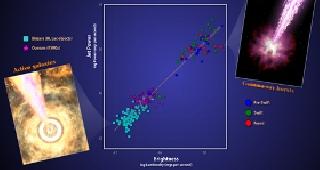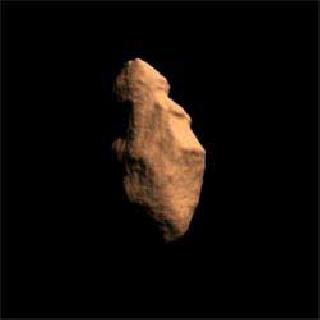
Astronomers examining the properties of black hole jets compared 54 gamma-ray bursts with 234 active galaxies classified as blazars and quasars. Surprisingly, the power and brightness of the jets share striking similarities despite a wide range of black hole mass, age and environment. A NASA photo
WASHINGTON (PTI): NASA's Swift satellite and Fermi Gamma-ray Space Telescope have found that high-speed jets launched from active black holes possess fundamental similarities regardless of mass, age or environment.
The result provides a tantalising hint that common physical processes are at work.
"What we're seeing is that once any black hole produces a jet, the same fixed fraction of energy generates the gamma-ray light we observe with Fermi and Swift," said lead researcher Rodrigo Nemmen, a NASA Postdoctoral Program (NPP) fellow at NASA's Goddard Space Flight Center in Greenbelt.
Gas falling toward a black hole spirals inward and piles up into an accretion disk, where it becomes compressed and heated.
Near the inner edge of the disk, on the threshold of the black hole's event horizon - the point of no return - some of the material becomes accelerated and races outward as a pair of jets flowing in opposite directions along the black hole's spin axis.
These jets contain particles moving at nearly the speed of light, which produce gamma rays -- the most extreme form of light -- when they interact.
"We don't fully understand how this acceleration process occurs, but in active galaxies we see jets that have operated so long that they've produced trails of gas extending millions of light-years," Sylvain Guiriec, an NPP fellow at Goddard and a co-author on the study, said in a statement.
At the other end of the scale are gamma-ray bursts (GRBs), the most powerful explosions in the Universe.
Astronomers believe that the most common type of GRB heralds the death of a massive star and the birth of a stellar-mass black hole.
When the star's energy-producing core runs through its store of fuel, it collapses and forms a black hole. As the star's overlying layers cascade inward, an accretion disk forms and the black hole launches a jet.
The particles in some GRB jets have been clocked at speeds exceeding 99.9 per cent the speed of light. When the jet breaches the star's surface, it produces a pulse of gamma rays typically lasting a few seconds.
To search for a trend across a wide range of masses, the scientists looked at the galactic-scale equivalent of GRB jets. These come from the brightest classes of active galaxies, blazars and quasars, which sport jets that likewise happen to point our way.
 Previous Article
Previous Article Next Article
Next Article













The Indian Air Force, in its flight trials evaluation report submitted before the Defence Ministry l..
view articleAn insight into the Medium Multi-Role Combat Aircraft competition...
view articleSky enthusiasts can now spot the International Space Station (ISS) commanded by Indian-American astr..
view article